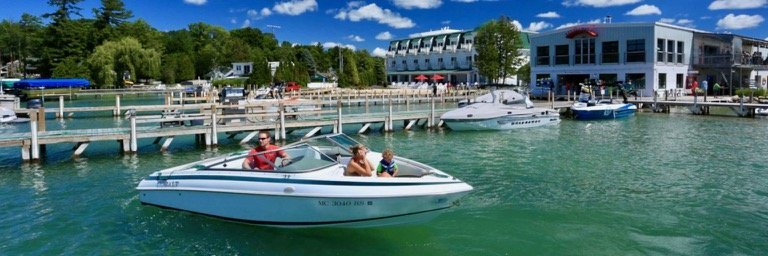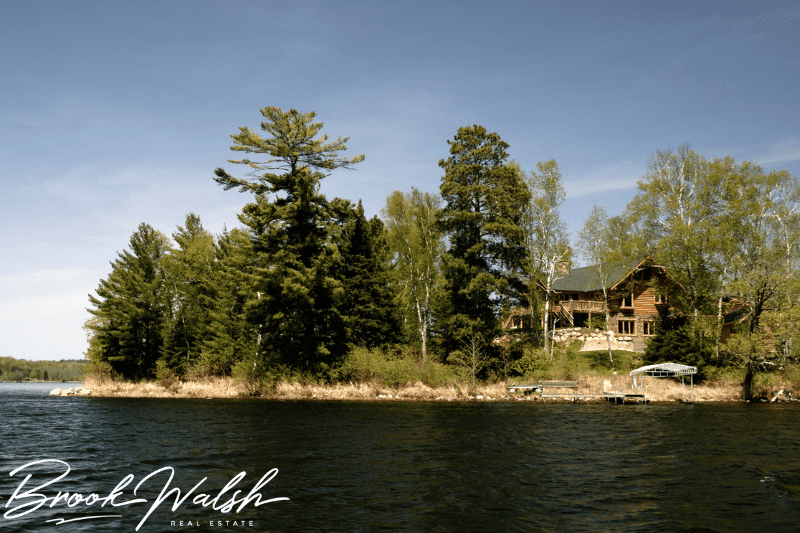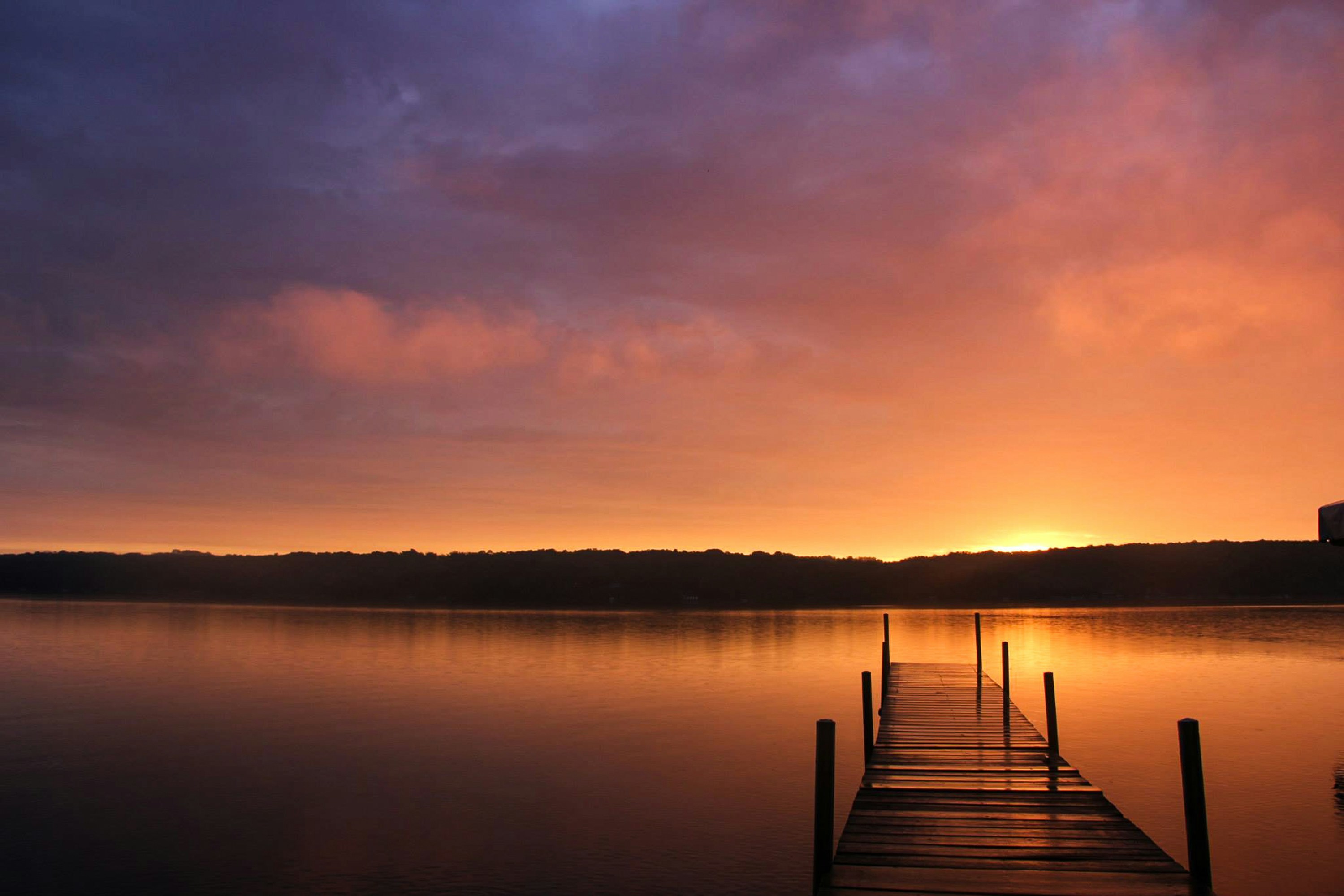Introduction

Nestled in the heart of Michigan, Walloon Lake is a picturesque freshwater lake that captivates both locals and visitors with its serene beauty and vibrant ecosystem. Renowned for its clear waters and scenic surroundings, Walloon Lake offers a perfect getaway for nature enthusiasts, recreational activities, and a variety of water sports. The lake holds historical significance as well, being a favored retreat of the famous author Ernest Hemingway, who spent many summers here.
Understanding the depth of Walloon Lake is crucial for several reasons. For recreational purposes, knowing the lake's depth ensures the safety and enjoyment of activities such as boating, fishing, and swimming. From an environmental perspective, the depth plays a significant role in the lake's ecosystem, influencing water temperature, oxygen levels, and the habitats of various aquatic species. Additionally, scientific studies and environmental monitoring rely on accurate depth measurements to assess the health of the lake, predict weather patterns, and develop conservation strategies. Therefore, exploring the depth of Walloon Lake provides valuable insights that benefit both human enjoyment and ecological preservation.
There are many different housing options in Walloon Lake including condominiums for sale, downtown homes for sale, land lover homes for sale, luxury homes for sale, and waterfront homes for sale.
Section 1: Overview of Walloon Lake

Location and Geographical Details
Walloon Lake is situated in the northern part of Michigan’s Lower Peninsula, spanning Charlevoix and Emmet counties. The lake is roughly eight miles long and boasts a shoreline of approximately 30 miles, making it a substantial body of water in the region. Walloon Lake is characterized by its five distinct bays: North Arm, West Arm, Wildwood, Foot, and Mud Lake, each contributing to its unique shape and diverse aquatic habitats. The lake drains into Lake Michigan through the Bear River, creating a vital connection between the two water bodies.
Historical Significance
Walloon Lake holds a rich historical significance, particularly noted for its connection to the famous American author, Ernest Hemingway. Hemingway’s family owned a cottage on the lake's shore, and he spent many of his formative summers there. These experiences greatly influenced his writing, with Walloon Lake being mentioned in several of his works. The area around the lake also developed as a popular resort destination in the late 19th and early 20th centuries, attracting tourists seeking respite in its natural beauty and tranquility.
Recreational Activities Available
Walloon Lake offers a plethora of recreational activities that cater to various interests and ages. The lake’s clear, clean waters are ideal for swimming, boating, and water skiing. Anglers find Walloon Lake a prime spot for fishing, with species such as bass, walleye, and northern pike populating its depths. Kayaking and paddleboarding are popular activities for those looking to explore the lake at a more leisurely pace. In addition to water sports, the surrounding areas provide ample opportunities for hiking, biking, and wildlife watching, making Walloon Lake a year-round destination for outdoor enthusiasts. The lake's vibrant community hosts events and festivals throughout the year, further enriching the visitor experience.
Section 2: Physical Characteristics of Walloon Lake
Size and Surface Area
Walloon Lake spans an impressive area of approximately 4,270 acres, making it one of the larger inland lakes in Michigan. Its shoreline extends for about 30 miles, encompassing a diverse range of landscapes from sandy beaches to forested areas. The lake's unique shape, characterized by its five distinct bays—North Arm, West Arm, Wildwood, Foot, and Mud Lake—adds to its scenic beauty and ecological diversity.
Water Volume
The water volume of Walloon Lake is substantial, contributing to its status as a significant freshwater resource in the region. The lake holds an estimated 158 billion gallons of water. This large volume supports a thriving aquatic ecosystem and ensures a steady supply of fresh water for various uses, including recreation and local water needs.
Average Depth
Walloon Lake has an average depth of around 30 feet. This moderate depth supports a wide range of aquatic life and provides suitable conditions for various recreational activities such as swimming, boating, and fishing. The average depth also plays a crucial role in maintaining the lake's ecological balance, influencing water temperature and oxygen levels.
Maximum Depth
The maximum depth of Walloon Lake reaches approximately 100 feet. This significant depth is found in the deeper sections of the lake, particularly in the central areas and some of the deeper bays. The deep waters create unique habitats for fish and other aquatic species, supporting a diverse and healthy ecosystem. Additionally, the depth variations contribute to the lake's overall attractiveness for recreational fishing, offering opportunities to catch a variety of fish species in different parts of the lake.
Section 3: Measuring the Depth of Walloon Lake

Methods Used to Measure Lake Depth
Accurately measuring the depth of Walloon Lake is essential for understanding its physical characteristics and ensuring safe and enjoyable recreational activities. Several methods have been employed over the years to gauge the lake's depth, from traditional techniques to modern technology.
Sonar Technology
Sonar technology is the most widely used method for measuring lake depth today. This technology employs sound waves to determine the distance between the water surface and the lake bed. A sonar device, typically mounted on a boat, emits sound pulses that travel through the water and reflect off the bottom. The time it takes for the sound waves to return is measured and converted into depth readings. This method provides highly accurate and detailed maps of the lake's underwater topography. Sonar surveys are particularly useful for identifying variations in depth, such as deep pockets and submerged structures, which are critical for navigation, fishing, and scientific research.
Historical Methods and Records
Before the advent of sonar technology, lake depth was measured using more manual methods. One common historical technique involved using a weighted line or lead line, which was lowered into the water until it touched the lake bed. The length of the line needed to reach the bottom was then measured to determine the depth. While this method was straightforward, it was time-consuming and less accurate, especially in larger lakes with varying depths.
Historical records and surveys also provide valuable insights into the lake's depth over time. Early explorers and surveyors often recorded depth measurements as part of their mapping efforts, and these records can be compared with modern data to observe changes in the lake's depth and underwater landscape.
Comparison with Other Lakes in the Region
When compared to other lakes in the region, Walloon Lake's depth characteristics are relatively moderate. For instance, Torch Lake, another prominent lake in northern Michigan, is significantly deeper, with a maximum depth of approximately 285 feet. In contrast, nearby Crooked Lake has a maximum depth of around 50 feet, making Walloon Lake deeper than some of its regional counterparts but shallower than others like Torch Lake.
Walloon Lake's average depth of 30 feet is typical for many inland lakes in Michigan, providing a balanced environment that supports a diverse range of aquatic life and recreational activities. The lake's maximum depth of 100 feet places it in the mid-range compared to other regional lakes, offering sufficient depth for various fish species and contributing to its popularity among anglers.
Understanding and comparing the depth of Walloon Lake with other lakes in the region highlights its unique characteristics and reinforces its importance as a recreational and ecological asset in northern Michigan.
Section 4: Significance of the Lake’s Depth
Impact on Marine Life and Ecosystem
The depth of Walloon Lake plays a crucial role in shaping its marine life and overall ecosystem. The varying depths create different habitats that support a diverse range of aquatic species. In the shallower areas, sunlight penetration fosters the growth of aquatic plants, which provide food and shelter for smaller fish and invertebrates. The deeper regions, with their cooler temperatures and lower light levels, are ideal for larger fish species such as bass, walleye, and northern pike.
The depth also affects the stratification of the lake, which is the layering of water at different temperatures. During the summer, the lake typically stratifies into three distinct layers: the warm upper layer (epilimnion), the cooler middle layer (metalimnion), and the cold bottom layer (hypolimnion). This stratification impacts the distribution of oxygen and nutrients, which in turn influences the types of organisms that can thrive at various depths. Maintaining a healthy balance between these layers is essential for the overall health of the lake's ecosystem.
Effects on Recreational Activities
Walloon Lake's depth significantly influences the types and quality of recreational activities available. For boating enthusiasts, the lake's deeper sections provide ample space for safe navigation and water sports such as water skiing and wakeboarding. The varied depths also make Walloon Lake a prime location for fishing, offering anglers the opportunity to catch different species that inhabit the lake's diverse underwater environments.
Swimmers benefit from the lake's clear and clean waters, which are maintained partly due to its depth. The deeper areas help to keep the water cooler and reduce the likelihood of algal blooms, making it a more pleasant and safe environment for swimming. Additionally, the depth variations offer unique spots for diving and snorkeling, where individuals can explore the underwater landscape and observe aquatic life in its natural habitat.
Influence on Local Climate and Weather Patterns
The depth of Walloon Lake also has a notable impact on the local climate and weather patterns. Large, deep lakes like Walloon can moderate the surrounding area's temperature, creating a microclimate. During the summer, the lake absorbs heat, which helps to cool the air and reduce extreme temperatures. In the winter, the stored heat is slowly released, which can mitigate the severity of cold snaps and reduce the likelihood of early frosts in the surrounding areas.
Furthermore, the lake's depth affects its ability to retain and distribute water throughout the year. Deeper lakes tend to have more stable water levels, which can influence local weather patterns by providing a consistent source of moisture for precipitation. This stability can also help buffer the effects of droughts and floods, contributing to a more predictable and balanced local climate.
In summary, the depth of Walloon Lake is a critical factor that shapes its marine life, enhances recreational activities, and influences the local climate. Understanding and preserving this depth is essential for maintaining the lake's ecological health and ensuring it remains a cherished natural resource for future generations.
Section 5: Environmental and Ecological Considerations

Water Quality and Depth Relationship
The depth of Walloon Lake is closely linked to its water quality, impacting everything from temperature stratification to nutrient distribution. Deeper lakes often have better water quality due to the stratification of water layers, which helps to separate warmer, nutrient-rich waters from cooler, oxygen-poor layers. This separation is crucial in maintaining a balanced ecosystem, as it allows different species to thrive in their preferred habitats. The cooler, deeper waters can sustain fish and other aquatic life that require specific oxygen levels and temperatures, while the warmer surface layers support plant growth and smaller organisms.
Furthermore, the depth can influence the lake’s ability to dilute and break down pollutants. Deep lakes like Walloon have a higher capacity to absorb and process contaminants without significantly affecting overall water quality. This natural buffering capacity is essential for maintaining the lake’s ecological health, especially in the face of increased human activity and potential pollution sources.
Conservation Efforts
Recognizing the importance of Walloon Lake’s depth and overall health, various conservation efforts have been implemented to protect and preserve this valuable natural resource. Local organizations and community groups play a pivotal role in these efforts, focusing on several key areas:
-
Water Quality Monitoring: Regular monitoring of water quality helps to track changes in the lake’s condition and identify potential issues early. This includes measuring parameters such as temperature, pH, dissolved oxygen, and nutrient levels.
-
Habitat Restoration: Efforts to restore and preserve natural habitats around the lake’s shoreline and within its watershed are crucial. This includes planting native vegetation, reducing shoreline erosion, and protecting wetlands that filter runoff before it enters the lake.
-
Public Education and Outreach: Educating the local community and visitors about the importance of preserving Walloon Lake is essential for long-term conservation. Initiatives include workshops, informational campaigns, and promoting best practices for reducing pollution and protecting the lake.
-
Policy and Regulation: Implementing and enforcing policies that limit harmful activities, such as overdevelopment, excessive use of fertilizers, and improper waste disposal, helps to safeguard the lake’s health. Collaboration between local governments, environmental organizations, and residents is key to effective regulation.
Challenges in Maintaining Lake Health
Despite these conservation efforts, several challenges remain in maintaining the health of Walloon Lake:
-
Pollution: Runoff from agricultural fields, residential areas, and roads can introduce pollutants such as fertilizers, pesticides, and heavy metals into the lake. These substances can degrade water quality and disrupt the lake’s delicate ecological balance.
-
Invasive Species: Non-native species, such as zebra mussels and Eurasian watermilfoil, can outcompete native species and alter the lake’s ecosystem. Managing and preventing the spread of invasive species is a constant challenge.
-
Climate Change: Changes in climate patterns can affect the lake’s water levels, temperature stratification, and overall health. Increased temperatures can lead to more frequent and severe algal blooms, while altered precipitation patterns can impact water levels and quality.
-
Development Pressure: The scenic beauty and recreational opportunities of Walloon Lake attract development, which can lead to habitat destruction, increased runoff, and greater demand on the lake’s resources. Balancing development with conservation is essential to maintaining the lake’s health.
In conclusion, the depth of Walloon Lake is a fundamental aspect of its environmental and ecological health. Ongoing conservation efforts, combined with addressing the challenges posed by pollution, invasive species, climate change, and development, are crucial for preserving this natural treasure for future generations.
Section 6: Interesting Facts About Walloon Lake

Unique Features Related to Its Depth
Walloon Lake’s depth contributes to several unique features that distinguish it from other lakes in the region. One notable aspect is the lake’s crystal-clear water, which is a result of its deep basin and relatively low levels of suspended sediments. This clarity allows for excellent visibility underwater, making it a favorite spot for snorkeling and diving enthusiasts.
Another unique feature is the presence of submerged aquatic plants and diverse fish habitats in different depth zones. The variation in depth creates microenvironments that support a wide range of aquatic species, from shallow-water plants and fish to deep-water organisms. This biodiversity is a direct result of the lake’s depth and its impact on water temperature and oxygen distribution.
Anecdotes and Historical Events Tied to the Lake’s Depth
Walloon Lake has a rich history filled with fascinating anecdotes and events, many of which are tied to its depth. One such story involves the famous American author Ernest Hemingway, who spent his summers at his family’s cottage on the lake. Hemingway often explored the lake’s deeper regions while fishing, and his experiences at Walloon Lake influenced several of his stories and novels.
Another historical event linked to the lake’s depth is the sinking of several boats over the years. Some of these vessels, now resting at the bottom of the lake, have become popular sites for scuba divers. These underwater wrecks offer a glimpse into the past and are a testament to the lake’s storied history.
There are also legends of Walloon Lake’s depth being a hiding place for treasures and artifacts from earlier times. While these tales add a layer of mystery and allure to the lake, they also highlight the curiosity and fascination people have with its underwater world.
Contributions to Local Culture and Tourism
Walloon Lake’s depth significantly contributes to local culture and tourism, making it a prominent attraction in the region. The lake’s pristine waters and diverse recreational opportunities draw visitors year-round, boosting the local economy and fostering a vibrant community.
Tourism activities such as boating, fishing, and water sports are heavily influenced by the lake’s depth, providing varied experiences for different skill levels and interests. Fishing tournaments and boating events are regularly held on the lake, attracting participants and spectators from across the state and beyond.
The depth of Walloon Lake also plays a role in cultural events and festivals. The lake’s scenic beauty and tranquil environment serve as a backdrop for celebrations, art shows, and community gatherings, reinforcing its importance in the local culture. Hemingway’s legacy, tied to his adventures on the lake, is celebrated through literary events and tours, further embedding the lake in the cultural fabric of the area.
In addition to recreational and cultural activities, Walloon Lake’s depth supports environmental tourism. Visitors interested in ecology and conservation can explore the lake’s diverse habitats, learn about its unique ecosystems, and participate in preservation efforts. Educational programs and guided tours offer insights into the importance of maintaining the lake’s health and the role of depth in its ecological dynamics.
In summary, Walloon Lake’s depth is a defining feature that enriches its unique characteristics, historical significance, and contributions to local culture and tourism. From its clear waters and diverse habitats to its storied past and vibrant community, the depth of Walloon Lake is integral to its identity and allure.
Conclusion

Walloon Lake’s depth is a fundamental aspect that defines its unique character and ecological richness. With a maximum depth of approximately 100 feet and an average depth of around 30 feet, the lake supports a diverse range of aquatic habitats and recreational activities. Its crystal-clear waters, varying depth zones, and historical significance add to its allure, making it a cherished natural resource in northern Michigan.
Ongoing research and conservation efforts are essential for maintaining the health and beauty of Walloon Lake. Accurate depth measurements and water quality monitoring help ensure the lake’s ecological balance and recreational safety. Conservation initiatives, such as habitat restoration and pollution prevention, are crucial for protecting this pristine environment from the challenges posed by human activity and climate change.
To preserve Walloon Lake for future generations, it is vital for both visitors and residents to support these efforts actively. Simple actions, such as reducing pollution, respecting wildlife habitats, and participating in local conservation programs, can significantly impact the lake’s health. By working together, we can ensure that Walloon Lake remains a vibrant and thriving ecosystem, offering enjoyment and inspiration for many years to come.
For more information on how you can contribute to the preservation of Walloon Lake, consider joining local environmental organizations, participating in community clean-up events, and staying informed about conservation initiatives. Together, we can make a difference and protect this invaluable natural treasure.
Additional Resources
References to Studies and Articles on Walloon Lake
- "Ecological Assessment of Walloon Lake" - Michigan Department of Natural Resources. This study provides comprehensive data on the lake's water quality, aquatic life, and overall ecosystem health.
- "Historical Changes in the Water Quality of Walloon Lake" - Journal of Great Lakes Research. An article examining how human activity and natural processes have influenced the lake's water quality over the years.
- "Impact of Recreational Activities on Walloon Lake's Ecosystem" - Environmental Research Letters. A detailed analysis of how boating, fishing, and other recreational activities affect the lake’s ecological balance.
Links to Local Conservation Organizations
-
Walloon Lake Association and Conservancy (WLAC) - WLAC Website
- The WLAC focuses on preserving and protecting the lake through various initiatives, including water quality monitoring, habitat restoration, and educational programs.
-
Tip of the Mitt Watershed Council - Tip of the Mitt Website
- This organization works on broader watershed issues that affect Walloon Lake, providing resources and support for local conservation efforts.
-
Little Traverse Conservancy - Little Traverse Conservancy Website
- Dedicated to preserving the natural beauty and ecological health of northern Michigan, including areas around Walloon Lake.
Suggested Further Reading on Lake Ecosystems and Depths
-
"Lakes: The Biology of Lakes and Ponds" by Paul A. Keddy
- This book provides an in-depth understanding of lake ecosystems, covering topics such as aquatic plant and animal life, nutrient cycles, and the effects of depth on lake ecology.
-
"The Lakes Handbook: Limnology and Limnetic Ecology" by Patrick O'Sullivan and Colin S. Reynolds
- A comprehensive guide to the science of lakes, offering detailed insights into physical, chemical, and biological aspects of lake environments.
-
"Freshwater Ecology: Concepts and Environmental Applications" by Walter Dodds and Matt Whiles
- This textbook covers a wide range of topics related to freshwater ecosystems, including the influence of depth on various ecological processes.
-
"Understanding Lake Ecology" by Michigan State University Extension
- An accessible resource that explains the fundamentals of lake ecology, tailored specifically to Michigan’s inland lakes.
These resources provide valuable information and opportunities for engagement, helping to ensure the ongoing preservation and appreciation of Walloon Lake.
Posted by Brook Walsh on

Leave A Comment